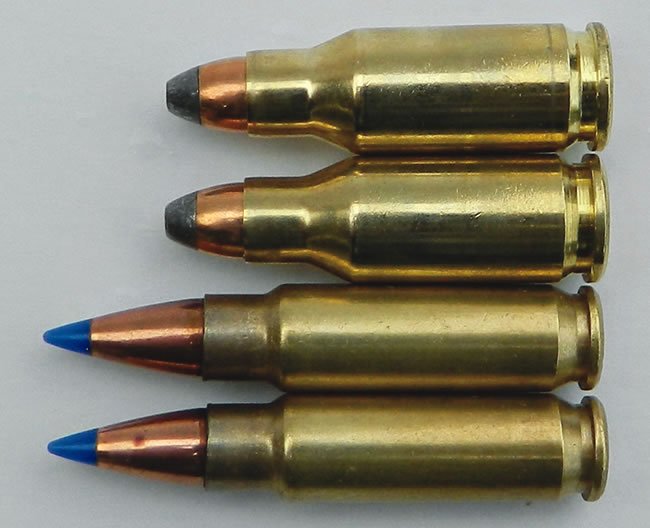
In an intriguing and extensive match-up, we pitted two handguns chambered for hot 22-caliber bottlenecks against each other. The 22 TCM and the 5.7x28mm cartridges are interesting on many levels, but also are not the most common or easily obtained rounds. Both handguns have a military heritage, but the Rock Island 1911 is pretty far removed from its 1911A1 45 ACP ancestor.
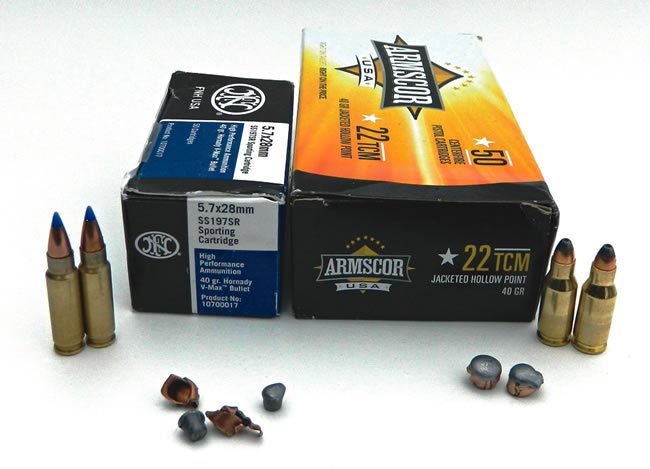
The Fabrique Nationale Herstal FiveseveN IOM (hereafter 5.7) pistol was designed as a personal defense weapon (PDW) for military use. The 5.7x28mm cartridge was designed with the ability to penetrate light armor. Good accuracy and low recoil were important attributes. Comparatively, the original 1911 was designed to stop a man or a horse. The 1911 was designed as an all-out fighting handgun in close quarters. One gets the impression the 5.7 was intended for use at a greater standoff distance. The adaptation of the 22 TCM cartridge to the 1911 gives shooters longing for a hot 22-caliber centerfire something to use in a familiar platform.
In this test we asked lots of questions, including what are the goals of a shooter purchasing either firearm. The handguns were tested for reliability, accuracy, and fit and finish. Which system is the most controllable and accurate? Finally, which is the more practical, better buy?
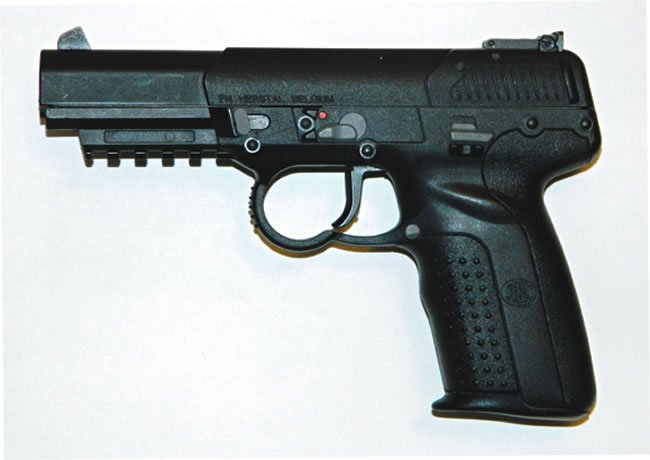
FNH USA FiveseveN IOM Pistol
5.7x28mm, $2000
In October 2014, FN America, LLC announced that is has completed the legal merger of FN Manufacturing, LLC and FNH USA, LLC into a single entity, FN America. FN America, a wholly-owned subsidiary of FN Herstal, S.A., will remain headquartered in McLean, Virginia and continue to provide products, training, and support services under the FNH USA brand name.
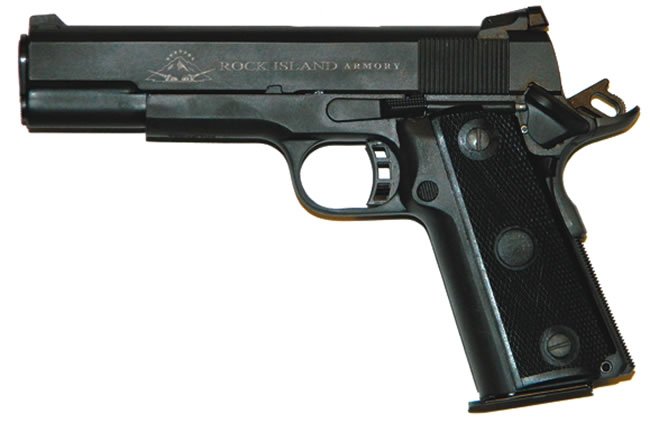
The company also has a development and technical center in Fredericksburg, Virginia and manufacturing operations in Columbia, South Carolina. The company produces a range of small arms for the U.S. military, such as M4/M4A1 carbines, M16 rifles, and several machine guns. In addition to manufacturing for the U.S. military, FN America also builds commercial handguns, including the FNX series of hammer-driven pistols, the FNS line of striker-fired pistols, and the FN 15 line of modern sporting rifles under the FNH USA brand.
The 5.7 handgun was developed as part of the NATO PDW program. The SMG version could spit out a dozen rounds with little muzzle rise and recoil. The pistol, some believe, is a horse without a course, while others praised the 5.7. Sales have been good enough to support the pistol in the FNH line up since its introduction. Opposition to the handgun from gun-control groups has doubtless aided sales to gun consumers, who seem to want what anti-gunners scream loudest about. Some of the early complaints were about the original armor-piercing NATO load being available to the public, but those rounds are now tightly limited to law enforcement. The Federal American Eagle FMJ loading we tested uses a conventional FMJ bullet rather than the military steel-core loading. We also tested the FN 40-grain V-Max loading and the SS195 lead-free loading. The cartridge is as important to the test as the unique handgun that chambers the 5.7x28mm cartridge, so we took additional time to run it through our ammunition protocol.
Our test gun was an original IOM model, which sells for about $2000 on GunBroker.com and other auction sites. Prices for current production guns run about $1250 at Cabela’s.
The pistol isn’t a small handgun, but it is lightweight. The 5.7 features a polymer frame and steel slide. The handgun weighs but 21 ounces unloaded. It is light, and this creates a whippy feel, which for some shooters must be addressed. The 5.7 is a single-action handgun with a concealed hammer. The pistol’s slide lock and safety are ambidextrous. The sights are the common 3-dot combat sights with an adjustable rear sight. There is sufficient texture to maintain a good grip, and the trigger guard easily accommodates gloved-hand use. The magazine release is reversible for right- or left-hand use. Slide-to-frame fit was good, and the pistol showed evidence of quality manufacturing. The magazine held 20 rounds. There are no feed lips, only a bevel on the chamber, ensuring excellent feed reliability. Disassembly was quick and easy. The slide was covered in polymer, which results in low maintenance.
We fired the FN first with the American Eagle 40-grain FMJ load at 5, 7, and 10 yards, using both one- and two-hand combat-firing techniques. This handgun was very easy to control. One of the raters posted five hits in the X ring at 7 yards in two seconds. The 5.7 was also very accurate, with the pistol exhibiting tight groups at all ranges. A decent 5.5-pound trigger aided in the firing equation. The pistol also demonstrated excellent accuracy during the benchrest-firing stage. This was among the most pleasant centerfire handguns we have ever fired. Bench resting did not involve developing a high tolerance for recoil; however, muzzle blast was evident. The FNH produced several 2-inch groups at 25 yards, with the American Eagle shooting the single best group of 1.8 inches.
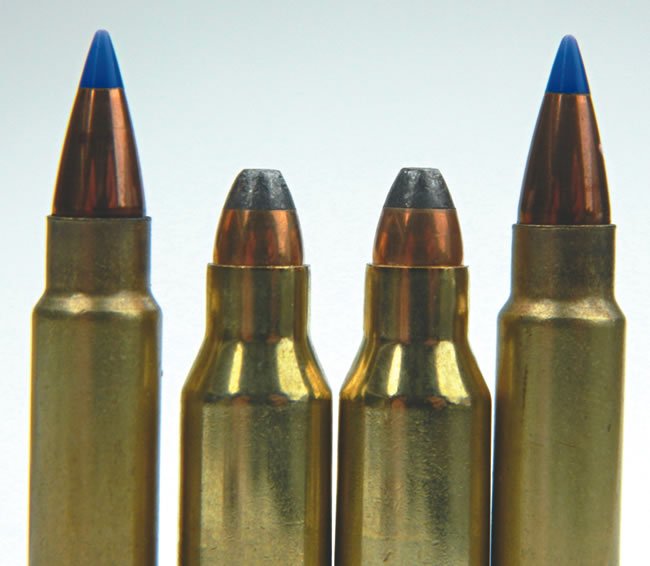
Accuracy certainly wasn’t a problem with this handgun. Neither was control. Offhand accuracy was quite good despite the whippy feeling. As a carry gun, the pistol felt bulky. Also, the safety’s location was a serious drawback. There was considerable difficulty in quickly accessing the safety during a draw. For average-size hands, it was a two-hand operation to get the pistol into operation. While some shooters claim to have mastered the safety’s rapid operation, our experienced raters were not impressed with the safety location. After a considerable workout, the pistol was deemed enjoyable to use and fire and was well made and accurate. As a defensive handgun, however, the safety location clearly was a drawback. The primary use for this handgun will probably be recreational for most, versus specialized use possible by a SWAT team. However, for anyone who cannot handle a heavier pistol or a heavily recoiling handgun, the 5.7 is leagues ahead of the 22 LR or 22 Magnum handgun, as the data in the ammunition test suggests.) Surprisingly enough, anyone who once wished to use a 22 Jet revolver will find the 5.7 fills the same needs much more efficiently.
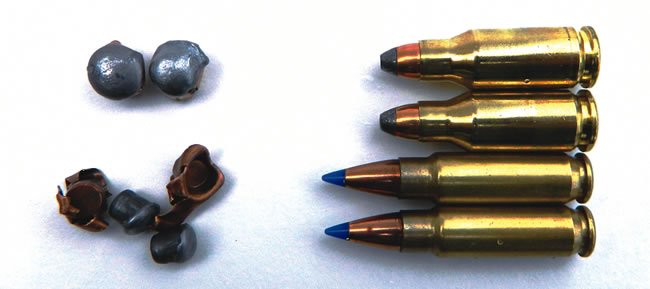
Our Team Said: The FNH is a good pistol, but it is one with several faults for personal defense, in our view. The safety is in a poor location for rapid manipulation. The pistol is bulky. The Rock Island pistol is heavy and big, but thanks to the slide-lock/safety design, the latter is faster to an accurate first-shot hit. Also, the 22 TCM pistol is more accurate than the FNH. Another factor that can’t be dismissed is the price. We chose to shoot an original IOM ($2000) here because we hadn’t tested it head to head when it was released, and we tested an FDE USG model in December 2011. Current 5.7s were running $1250 at Cabela’s at the time of testing — still more than double the RIA’s $550 counter price. Of course, 22 TCM rounds are cheaper than 5.7 ammo as well.
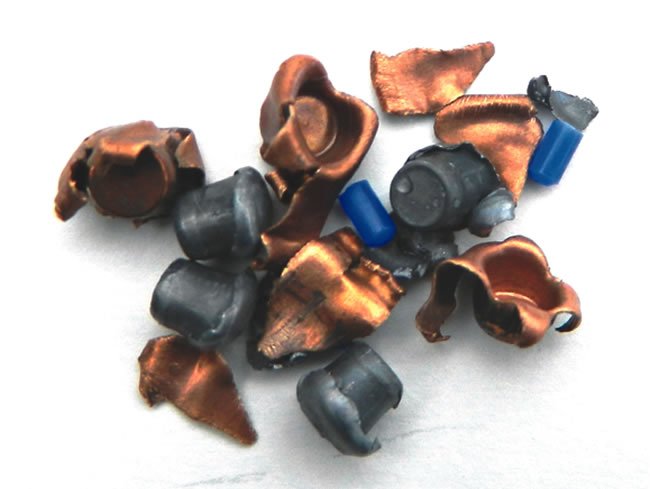
Rock Island Armory 22 TCM/9mm Combo
AC R1911-9mm-22TCM, $550
The price shown is the cost of the pistol at the time of testing from CenterfireSystems.com. The RIA 22 TCM is a modified version of the high-capacity target-grade 9mm handgun. We canvassed the big online gun sites and found few in stock, but the prices are attractive, from about $550 to $700.
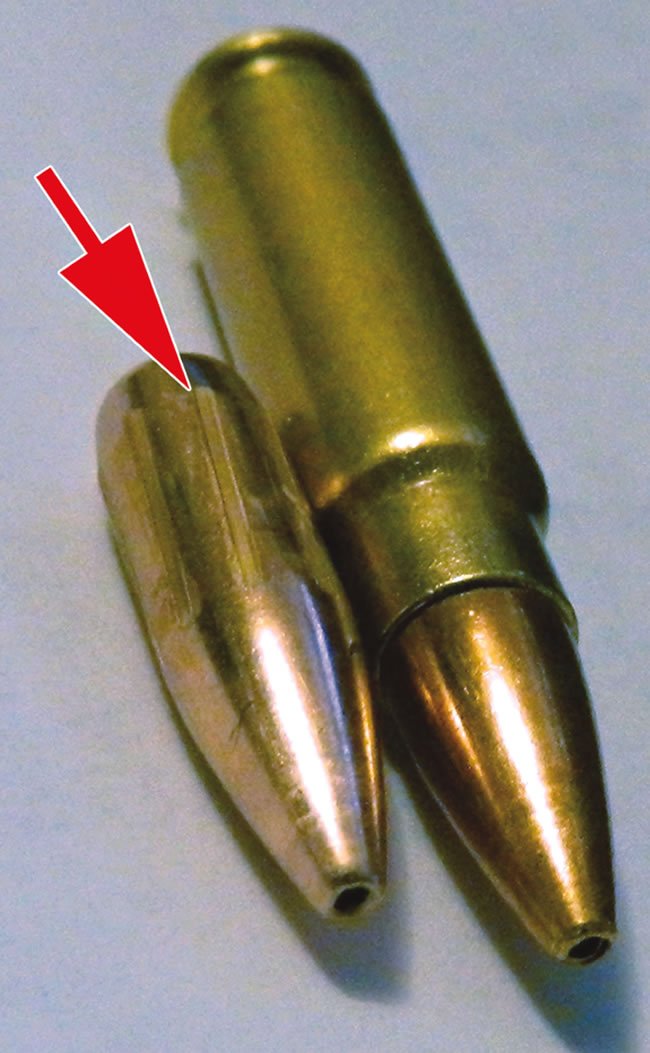
The pistol was supplied in a lockable case with the handgun, a single magazine, and a spare barrel and recoil spring in 9mm Luger. Right off the bat, we saw the Rock Island has both more and less than the FNH pistol. The FNH was supplied with three magazines. The Rock Island was supplied with a single magazine, which isn’t very helpful in a self-loading pistol even if that magazine holds 18 rounds. We did a search and found magazines for sale at an average of $25, and some were not available until a month later according to the retailer. So, to bring the magazine situation up to par with the 5.7x28mm pistol, we need to spend fifty additional bucks. That isn’t unreasonable, but we would prefer a spare be supplied with the handgun. In fact, we think three magazines is the minimum: one on the belt, one in the gun, and one resting.
But no matter what else we do, we cannot supply the FNH pistol with a 9mm barrel, whereas the 22 TCM comes with a spare 9mm barrel. The death of many cartridges has been their limited availability. The 41 Action Express was one, and the 400 Cor-Bon perhaps another, but either could be chambered in existing handguns in popular calibers and returned to 9mm or 45 ACP with a simple barrel change. The 9mm backup barrel offers real versatility.
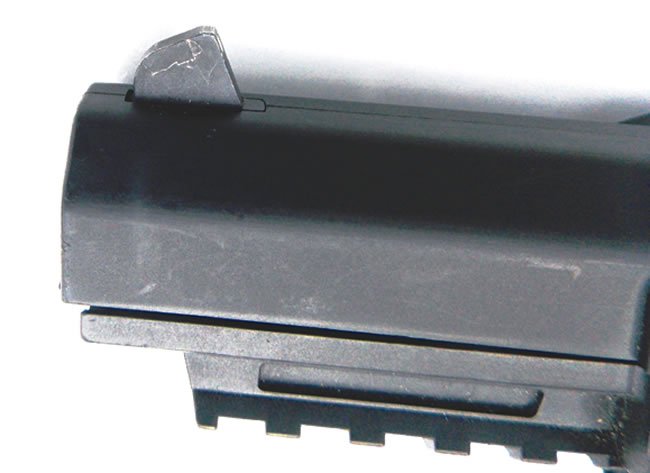
The 22 TCM was developed from a shortened 223 Remington cartridge. The rim diameter at .378 inch works well in a 9mm breechface. All that is required to convert the 22 TCM to 9mm Luger is to change the barrel and recoil spring.
As for the pistol itself, the Rock Island handgun is a double-column magazine 1911. The pistol uses the standard grip safety and slide lock safety of the 1911. There was no ambidextrous safety, as found on the RIA Tactical II. The pistol was finished in a matte black exterior. The finish seemed evenly applied, but it exhibited holster wear along the flats of the slide after modest use. The slide was finished in a flat-top configuration we find attractive. The safety was stiff in operation, but loosened after use. Originally, the safety was fast enough when moving to the Off position and no impediment to speed work, but very stiff when moving to the On position.
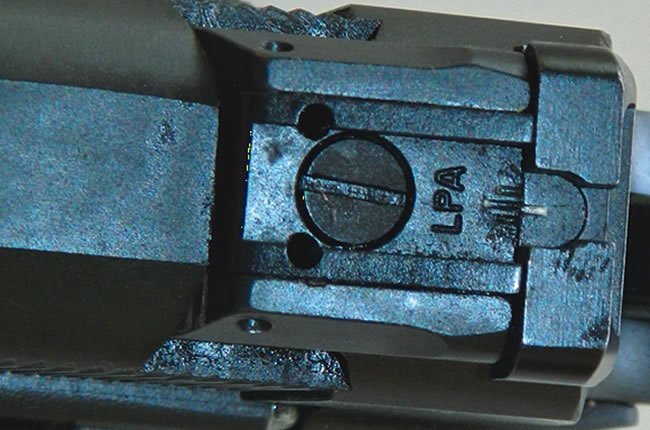
The grips are OK, but they looked and felt cheap, we thought. They could be replaced if the owner so chose. The right-hand panel seemed poorly fitted where an extension met the grip safety. They were a fair attempt at producing useful grips for an outsized frame. The sights were good examples of sporting and combat sights, with a fully adjustable rear sight and a post front. However, an insert in the front sight proved troublesome during the firing test. Lift the gun into the sun to aim, and the front sight disappeared. We blacked it out for the firing test. The pistol’s grip frame was large, but most raters were able to control the pistol and use it well. In 45 ACP perhaps there would have been a problem, but not with the 22 TCM and the 9mm Luger.
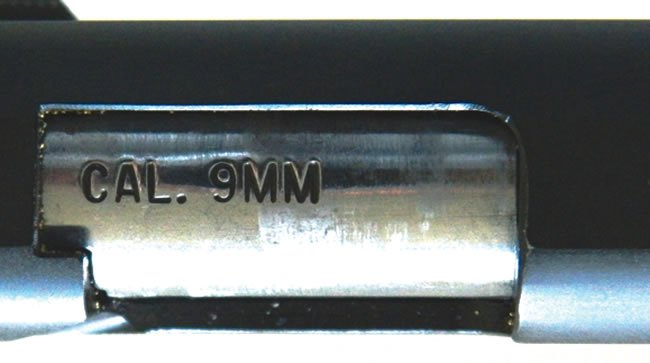
The sweet spot for the pistol was the trigger. Trigger compression was a tight and smooth 3.5 pounds with no creep. The trigger was a great aid in the excellent accuracy of the pistol. The handgun was heavy at 41 ounces unloaded — roughly twice the weight of the 5.7. While recoil isn’t a factor with either handgun, the 22 TCM Rock Island exhibited little movement in firing. When firing off hand at longer ranges, the heavier 22 TCM pistol proved to be more stable and capable of better practical accuracy, we thought.
The initial evaluation began with the pistol lubricated and loaded with the Armscor 40-grain rounds. Drawing from an Alien Gear IWB holster, we fired the pistol at attacker-sized targets at 5, 7, and 10 yards. The results were excellent. All raters remarked upon the ease of control. The pistol’s 7-pound recoil spring makes the handgun easy to cock and load, and the pistol’s light recoil was appealing to anyone who cannot use a heavier caliber for whatever reason. (The 1911 45 ACP uses a standard 16-pound recoil spring.) On the bench, the pistol turned in several 2.0-inch groups at a long 25 yards, and while the average was slightly greater, this is an accurate handgun.
While the focus of this test are the hot 22s, it was reasonable to test the 9mm barrel, as this is a big selling point of the pistol. If the conversion did not work out, the handgun’s use would be cut in half. And, frankly, for some shooters the novelty will wear off and they will still own what remains a credible and accurate high-capacity 9mm handgun. Beginning with Federal American Eagle 115 grain and moving to the Speer Gold Dot 147-grain JHP, the pistol with its 9mm barrel was controllable and accuracy was good. Those who believe the 9mm is a light kicker learned that there is a difference between the 22 TCM and the 9mm Luger. Accuracy was comparable with the 9mm Luger barrel and slide, averaging about 2.3 inches. It is good the pistol is supplied with adjustable sights, we found. The 9mm bullets’ dwell time in the barrel are greater and the loads correspondingly fire high. It is doubtful you will be able to use the same sight settings for both rounds.
More problematic, we encountered function problems with every JHP loading. The Hornady XTP failed to feed, with the bullet nose being caught on the feed ramp. We loaded the magazine with the Black Hills EXP and enjoyed a half-dozen rounds firing before this rounded-nose JHP also was caught on the feed ramp. No point in wasting further ammunition at this point. We were disappointed after the flawless showing with the 22 TCM cartridge. We fired 100 rounds of American Eagle 115-grain FMJ without a problem. The pistol was also rated down for the finish compared to the FNH and also the tight safety. However, the tight safety did not detract from combat ability, the problem was in placing the safety on, not off, where the gun would fire. The grips could have been better, but the pistol works in the primary caliber and it is accurate.
Our Team Said: Compared to the 40-grain V-Max 5.7x28mm load, the 22 TCM 40-grain load exhibited a 200-fps advantage. The 27-grain 5.7x28mm load is faster but uses a lighter bullet, so its energy isn’t comparable to the 22 TCM. Additionally, the 22 TCM bullet did not fragment. It expanded consistently. The 5.7x28mm V-Max loading penetrated less and fragmented. Compared cartridge to cartridge, we think the 22 TCM is the better cartridge.
If you want a hot 22-caliber centerfire self-loader, the RIA is accurate, more so than the FNH pistol, and costs much less. It is also more powerful. This is a great fun gun, easy to shoot and accurate. This is among the few affordable self-loaders useful for small-game hunting and predator control. Keep it on the hip during your chores, and a pesky coyote is in trouble out to 100 yards, and perhaps a little further.
Written and photographed by Bob Campbell, usingevaluations from Gun Tests team testers.
fnhusafiveseveniompistol5728mm.pdf





























